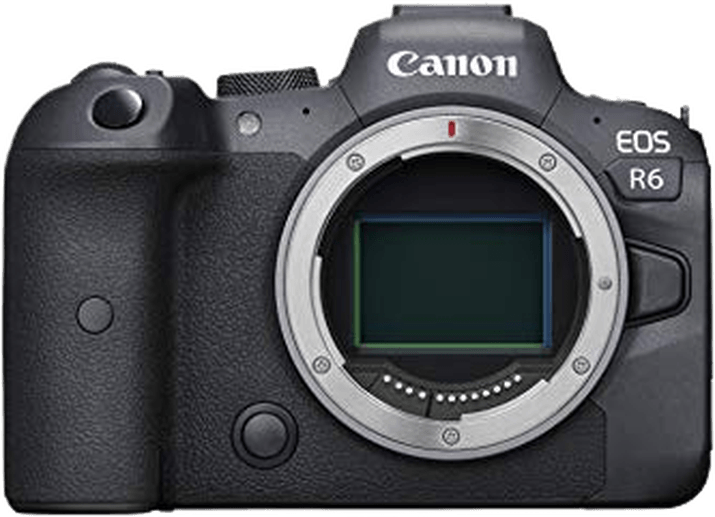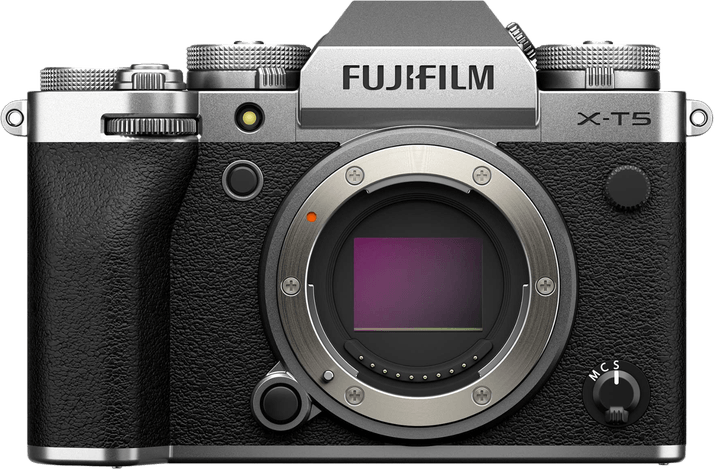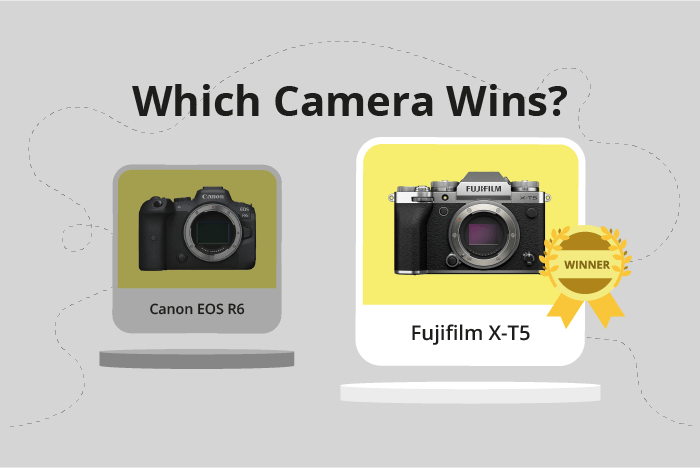Canon EOS R6 vs Fujifilm X-T5 Comparison
Canon EOS R6

Fujifilm X-T5

The Fujifilm X-T5 narrowly wins with a score of 81/100, compared to the Canon EOS R6‘s 80/100. Both cameras are mirrorless and have similar release dates, with the Canon EOS R6 being released in 2020 and the Fujifilm X-T5 in 2022.
The Canon EOS R6 has a larger size (138 x 98 x 88mm) and is heavier (680g) than the Fujifilm X-T5 (130 x 91 x 64mm and 557g). Despite its larger size, the Canon EOS R6 is still an excellent camera with a high score of 80/100.
The Fujifilm X-T5, however, outshines the Canon EOS R6 with its lower launch price of $1699 compared to the Canon EOS R6’s $2499. This price advantage, combined with its smaller size and lighter weight, makes the Fujifilm X-T5 a more appealing choice for photographers looking for a compact and affordable option.
Both cameras have their unique advantages, with the Canon EOS R6 offering a larger size and the Fujifilm X-T5 providing a more lightweight and cost-effective option. Ultimately, the choice between these two cameras depends on the user’s preferences and specific photography needs.
Canon EOS R6 vs Fujifilm X-T5 Overview and Optics
The Fujifilm X-T5 triumphs over the Canon EOS R6 in optics with a score of 81/100, as opposed to the R6’s 79/100. Both cameras possess several similarities in specifications, such as 20.1 and 40 megapixels, a CMOS sensor type, and image stabilization. Additionally, both cameras offer distinct advantages and disadvantages in terms of optics.
The Canon EOS R6 shares common ground with the Fujifilm X-T5 in terms of shooting speed and processor. Both cameras have a CMOS sensor type and image stabilisation. The R6, however, has a full-frame sensor size, a Digic X processor, and a DXOMARK sensor score of 90. These features contribute to the camera’s superior low-light performance and overall image quality.
On the other hand, the Fujifilm X-T5 stands out with its impressive 40-megapixel resolution, which is double that of the R6. This results in sharper and more detailed images, making the X-T5 better suited for large prints or cropping. Furthermore, the X-T5 has an APS-C sensor size and an X-Processor 5, which, although they may not match the R6’s specifications, still deliver excellent image quality. The X-T5 also has a Fujifilm X lens mount, offering a wide range of high-quality lenses.
While the Canon EOS R6 performs better in low-light situations and offers a larger sensor size, the Fujifilm X-T5 excels in image resolution and detail. Both cameras have their respective strengths, and the decision ultimately depends on the photographer’s preferences and requirements. The Fujifilm X-T5’s higher optics score suggests that it may be the preferable choice for those who prioritize resolution and detail, while the Canon EOS R6 may be more suitable for those who require better low-light performance.
Canon EOS R6 vs Fujifilm X-T5 Video Performance
The Canon EOS R6 outperforms the Fujifilm X-T5 in video capabilities with a score of 91/100, while the Fujifilm X-T5 scores 87/100. Both cameras share some common specifications, such as 4K video resolution for the Canon EOS R6 and 6K for the Fujifilm X-T5. They both have time-lapse functionality built-in, which is a useful feature for capturing stunning time-lapse videos.
The Canon EOS R6 has a higher video score due to its better video performance. It offers a maximum video frame rate of 120fps, which is double the Fujifilm X-T5’s 60fps. This means that the Canon EOS R6 can capture smoother slow-motion footage, giving users more creative options when shooting videos. The 4K resolution of the Canon EOS R6 is also sufficient for most videography needs and is widely used in the industry.
On the other hand, the Fujifilm X-T5 has a higher maximum video resolution at 6K, with video dimensions of 6240×4160. This might be an advantage for some users who require higher resolution footage for their projects. However, the lower frame rate of 60fps limits its slow-motion capabilities compared to the Canon EOS R6.
Considering the video capabilities of both cameras, the Canon EOS R6 stands out as the better option due to its higher video score and superior slow-motion capabilities. The Fujifilm X-T5’s higher resolution may be beneficial for some users, but the lower frame rate could be a drawback for others. Ultimately, the choice between these two cameras for video purposes depends on the user’s specific needs and preferences.
Canon EOS R6 vs Fujifilm X-T5 Features and Benefits
The Canon EOS R6 and the Fujifilm X-T5 both have a feature score of 85/100, making them evenly matched in this category. Both cameras share several common specifications, including a 3-inch screen size, touchscreen capabilities, flip screens, and the absence of GPS. Additionally, both cameras have WIFI and Bluetooth connectivity.
The Canon EOS R6 has a screen resolution of 1,620,000 dots, which is lower than the Fujifilm X-T5’s 1,840,000 dots. This difference in resolution makes the Fujifilm X-T5’s screen sharper and more detailed, providing a better viewing experience for users.
However, despite the lower screen resolution, the Canon EOS R6 remains on par with the Fujifilm X-T5 in terms of overall features. The equal feature score of 85/100 for both cameras indicates that they offer a similar level of functionality and performance.
In some aspects, the Fujifilm X-T5 may be considered superior due to its higher screen resolution. However, this factor alone does not make it a better camera than the Canon EOS R6. The equal feature score shows that both cameras have strong offerings in their respective categories.
After considering the specifications and feature scores of both the Canon EOS R6 and the Fujifilm X-T5, it is clear that neither camera has a significant advantage over the other. Both cameras provide users with a range of high-quality features and capabilities. Buyers should consider other factors, such as price and personal preferences, when deciding between these two cameras.
Canon EOS R6 vs Fujifilm X-T5 Storage and Battery
The Fujifilm X-T5 outperforms the Canon EOS R6 in storage and battery with a score of 76/100, compared to the R6’s 68/100. Both cameras share common specs, such as two memory card slots and USB charging capabilities. They also accept SD, SDHC, and SDXC memory cards, with the R6 being UHS-II compatible and the X-T5 UHS-I compatible.
The X-T5 excels with a longer battery life of 580 shots, using the NP-W235 battery type. This is a significant advantage over the R6’s 360 shots with its LP-E6NH battery. Users can expect more shooting time with the X-T5 before needing to recharge or replace batteries.
However, the R6 offers better memory card compatibility with UHS-II, providing faster read and write speeds compared to the X-T5’s UHS-I. This means the R6 can handle larger files and faster bursts more efficiently, which could be beneficial for certain users.
Considering these factors, the Fujifilm X-T5 is the better option for extended battery life, while the Canon EOS R6 provides superior memory card compatibility and performance.
Alternatives to the Canon EOS R6 and Fujifilm X-T5
Are you still undecided about which camera is right for you? Have a look at these popular comparisons that feature the Canon EOS R6 or the Fujifilm X-T5:

